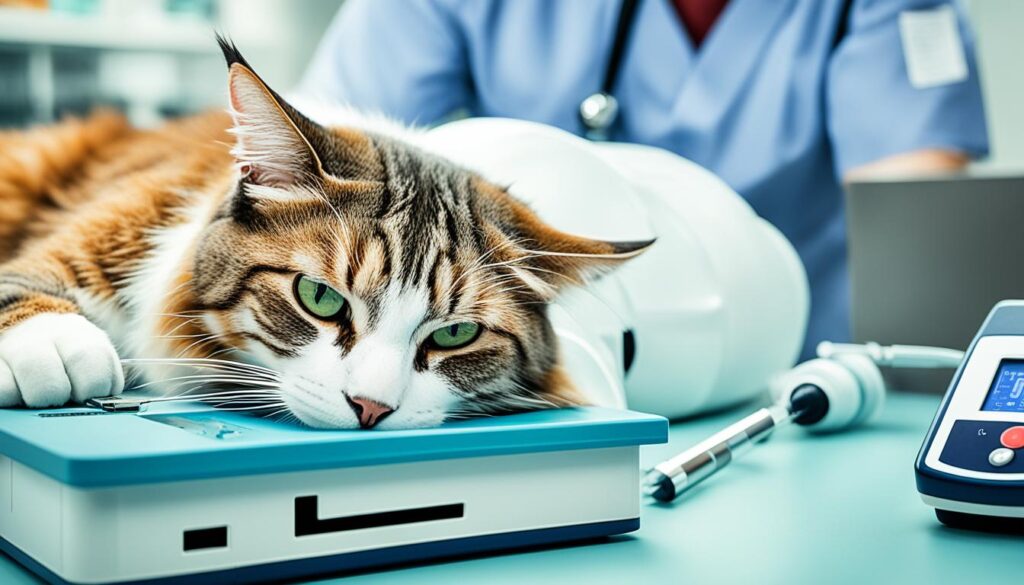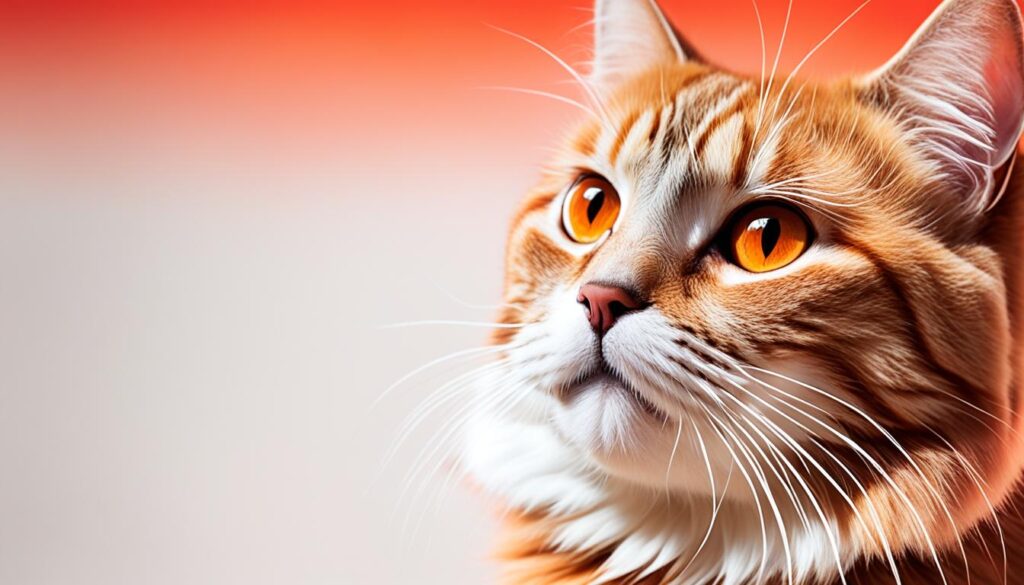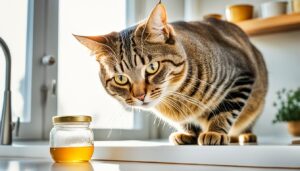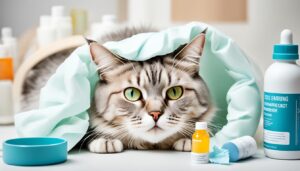Did you know that anything above 250 to 300 mg/dL is considered dangerously high blood sugar in cats?
High blood sugar, or hyperglycemia, in cats can lead to serious complications if left untreated. It is important to recognize the signs of high blood sugar and understand how to manage this condition effectively.
Understanding Dangerously High Blood Sugar in Cats: Key Takeaways
- Dangerously high blood sugar in cats is above 250 to 300 mg/dL.
- Untreated high blood sugar can lead to serious complications.
- Signs of high blood sugar in cats include increased thirst, weight loss, excessive appetite, and lethargy.
- Treatment involves insulin administration, dietary changes, and regular monitoring of blood sugar levels.
- Maintaining a healthy weight and a stress-free environment can help prevent high blood sugar in cats.
Causes of High Blood Sugar in Cats
High blood sugar in cats, also known as hyperglycemia, can be caused by various factors. The leading cause of high blood sugar in cats is diabetes mellitus, a condition in which the pancreas does not produce enough insulin or the insulin produced is not effective in reducing blood glucose levels. Diabetes can develop in any cat, but it is more common in cats over 6 years old and those that are overweight or obese.
In addition to diabetes, other factors that can contribute to high blood sugar in cats include:
- Stress: Cats that experience significant stress, such as drastic changes in their environment or routine, may develop temporary high blood sugar levels.
- Cushing’s disease: This hormonal disorder can disrupt the body’s ability to regulate blood sugar levels, leading to elevated glucose levels in cats.
- Acromegaly: A rare condition caused by an overproduction of growth hormone, acromegaly can interfere with insulin function and result in high blood sugar in cats.
- Recurrent pancreatitis: Inflammation of the pancreas can affect insulin production, leading to elevated blood sugar levels.
- Kidney failure: Cats with kidney disease may experience elevated blood sugar levels due to imbalances in various metabolic processes.
- Certain medications: Some medications, such as corticosteroids, can increase blood sugar levels in cats.
Identifying and addressing the underlying cause of high blood sugar is crucial for effective management. By understanding the factors that contribute to elevated blood sugar levels in cats, veterinarians can develop targeted treatment plans to help stabilize glucose levels and promote better overall health.
Factors Contributing to High Blood Sugar in Cats
| Factor | Description |
|---|---|
| Diabetes mellitus | The leading cause of high blood sugar in cats, resulting from inadequate insulin production or insulin resistance. |
| Stress | Significant stress or changes in the cat’s environment can lead to temporary high blood sugar. |
| Cushing’s disease | A hormonal disorder that disrupts the body’s ability to regulate blood sugar levels. |
| Acromegaly | An overproduction of growth hormone, which interferes with insulin function. |
| Recurrent pancreatitis | Inflammation of the pancreas affecting insulin production. |
| Kidney failure | Imbalances in metabolic processes due to kidney disease. |
| Certain medications | Some medications, including corticosteroids, can increase blood sugar levels in cats. |
Symptoms of High Blood Sugar in Cats
Cats with high blood sugar can display various symptoms that indicate an underlying issue. Recognizing these signs is crucial in identifying and addressing the problem promptly. Some common symptoms of high blood sugar in cats include:
- Increased thirst and urination: Cats with high blood sugar often experience excessive thirst and urination as their bodies attempt to eliminate the excess glucose through urine.
- Weight loss: Unexplained weight loss can occur in cats with high blood sugar, despite having an increased appetite.
- Excessive appetite: Cats with high blood sugar may exhibit an insatiable appetite, yet continue to lose weight.
- Lethargy: Cats may become lethargic and lack energy due to the imbalances caused by high blood sugar.
- Poor coat condition: High blood sugar can affect a cat’s coat, causing it to appear dull, brittle, or matted.
In severe cases, high blood sugar can lead to a life-threatening condition called diabetic ketoacidosis (DKA). Cats with DKA may also experience additional symptoms such as dehydration, vomiting, rapid breathing, and a fruity odor to the breath. If you notice any of these symptoms in your cat, it is crucial to seek immediate veterinary attention.
| Common Symptoms of High Blood Sugar in Cats |
|---|
| Increased thirst and urination |
| Weight loss |
| Excessive appetite |
| Lethargy |
| Poor coat condition |
Diagnosing High Blood Sugar in Cats
Diagnosing high blood sugar in cats involves various tests and examinations to determine the underlying cause and severity of the condition.
Routine Blood Work and Glucometer Testing
One of the primary methods used to diagnose high blood sugar in cats is through routine blood work. A veterinarian will analyze the cat’s blood sample to measure the blood glucose levels. This test can provide valuable insights into the cat’s overall blood sugar status.
In addition to routine blood work, a glucometer may be used to monitor the cat’s blood glucose levels at home. This handheld device measures blood sugar levels from a small drop of blood obtained through a quick and painless prick of the cat’s ear or paw. Monitoring blood glucose levels at home can help pet owners keep track of their cat’s condition and make necessary adjustments to their treatment plan.
Urine Testing
Urine testing is another diagnostic tool used to check for the presence of glucose in the cat’s urine. Glucose present in the urine is an indication of high blood sugar. While urine testing can provide useful information, it is not as accurate as blood testing for determining the cat’s current blood glucose levels.
History, Physical Examination, and Other Diagnostic Tests
A thorough history and physical examination are crucial for identifying signs and symptoms of high blood sugar in cats. Pet owners should provide accurate information about their cat’s behavior, including changes in appetite, thirst, urination frequency, weight fluctuations, and overall energy levels.
Additional diagnostic tests, such as imaging (X-rays, ultrasound) and blood chemistry panels, may be necessary to identify any underlying causes of high blood sugar. This comprehensive approach helps veterinarians pinpoint the specific condition affecting the cat and develop an effective treatment plan accordingly.
Working closely with a veterinarian, providing detailed information, and following recommended diagnostic procedures are key to accurately diagnosing high blood sugar in cats. The diagnostic process aims to uncover the root cause of the condition and determine the most appropriate treatment approach for each individual cat.
| Diagnosing High Blood Sugar in Cats |
|---|
| Routine Blood Work and Glucometer Testing |
| Urine Testing |
| History, Physical Examination, and Other Diagnostic Tests |
Treating High Blood Sugar in Cats
When it comes to managing high blood sugar in cats, the primary treatment approach involves insulin administration and dietary changes. As a responsible cat owner, it’s essential to work closely with your veterinarian to ensure the best care for your furry friend.
Insulin administration plays a crucial role in controlling your cat’s blood sugar levels. Your veterinarian will determine the appropriate type of insulin for your cat’s needs and teach you how to administer the injections at home. There are different insulin options available, including short-acting and long-acting varieties, and the choice depends on your cat’s individual circumstances.
In addition to insulin, a prescription diet may be recommended for your cat. This specialized diet helps manage blood sugar levels and provides the necessary nutrients for overall health. Strict dietary management is vital to keeping your cat’s blood sugar in check.
Regular monitoring of blood glucose levels is essential in managing high blood sugar in cats. Your veterinarian will guide you on the frequency of testing and help you interpret the results. By closely monitoring your cat’s blood sugar levels, you can make any necessary adjustments to the treatment plan to ensure optimal control.
Key Points:
- Insulin administration and dietary changes are the main treatments for high blood sugar in cats.
- Your veterinarian will prescribe the appropriate type of insulin and teach you how to administer the injections.
- A prescription diet may be recommended to help manage blood sugar levels.
- Regular monitoring of blood glucose levels is crucial for effective management.
By following the recommended treatment plan and working closely with your veterinarian, you can effectively manage high blood sugar in your cat and provide them with the care they need to live a healthy and happy life.
## HTML Tag Plan
– H2: Title
– P: Introduction
– P: Insulin administration
– P: Prescription diet
– P: Regular monitoring
– H3: Key Points
– UL: List of key points
– P: Conclusion
– IMG: Relevant image
Managing High Blood Sugar in Cats
Managing high blood sugar in cats involves a combination of insulin administration, dietary changes, and regular monitoring. It is important to follow your veterinarian’s instructions carefully regarding insulin dosage and timing, as well as feeding a prescribed diet. Regular monitoring of blood glucose levels is essential to ensure that the treatment is effective and to make any necessary adjustments.
Dietary Changes
A prescribed diet plays a crucial role in managing high blood sugar in cats. Your veterinarian may recommend a low-carbohydrate, high-protein diet to help regulate blood glucose levels. This type of diet can help stabilize your cat’s blood sugar and promote overall health. It is important to feed your cat a consistent amount of food at scheduled times to maintain a steady glucose level.
Insulin Administration
If your cat has been diagnosed with diabetes, insulin administration will be an essential part of managing their high blood sugar. Your veterinarian will prescribe the appropriate type of insulin and teach you how to administer it. Insulin injections are typically given under the skin, and the timing and dosage will be determined based on your cat’s individual needs. It is important to administer insulin as instructed to maintain stable blood sugar levels.
Regular Monitoring
Regular monitoring of your cat’s blood glucose levels is crucial for managing high blood sugar. Your veterinarian may recommend at-home monitoring using a glucometer or regular blood tests at the clinic. Monitoring allows you to track your cat’s response to treatment and make any necessary adjustments to insulin dosage or diet. It provides valuable information for maintaining stable blood sugar levels and preventing complications.
In addition to insulin administration, dietary changes, and regular monitoring, there are a few other important aspects to consider in managing high blood sugar in cats:
- Provide fresh water at all times to prevent dehydration, a potential complication of high blood sugar.
- Ensure your cat has a clean litter box to encourage regular urination.
- Create a stable and stress-free environment for your diabetic cat. Stress can affect blood sugar levels, so minimizing stressors such as loud noises or changes in routine can help with their overall management.
By following your veterinarian’s guidance and closely managing your cat’s high blood sugar, you can help improve their quality of life and minimize the risk of complications.
Potential Complications of High Blood Sugar in Cats

If left untreated, high blood sugar in cats can lead to various complications, affecting their overall health and well-being. It is important to be aware of these potential complications and seek proper veterinary care to prevent adverse outcomes.
1. Unhealthy Looking Coats
Cats with uncontrolled blood sugar levels may develop skin conditions that result in an unhealthy-looking coat. Their fur may become dull, thin, or oily, and they may experience hair loss or excessive shedding.
2. Liver Problems
High blood sugar can increase the risk of liver disease in cats. The liver plays a crucial role in regulating blood sugar levels, and when it is affected, it can further disrupt glucose metabolism, leading to a vicious cycle of worsening hyperglycemia.
3. Chronic Bacterial Infections
Elevated blood sugar weakens the immune system, making cats more susceptible to chronic bacterial infections. Common sites of infection include the urinary tract, skin, and respiratory system.
4. Hind-Leg Weakness
Prolonged high blood sugar levels can cause nerve damage, particularly in the hind legs of cats. This can result in weakness, difficulty walking, and impaired coordination.
5. Diabetic Ketoacidosis (DKA)
Uncontrolled high blood sugar in cats puts them at risk of developing diabetic ketoacidosis (DKA). DKA occurs when there is an insufficient supply of glucose for energy, leading to the breakdown of fats in the body. This metabolic imbalance can quickly become life-threatening if not addressed promptly.
It is crucial to closely monitor your cat’s health and behavior for any signs of complications resulting from high blood sugar levels. If you notice changes in their coat, liver function, or mobility, or if they display symptoms of infections, such as increased thirst, frequent urination, lethargy, or poor appetite, seek veterinary attention immediately.
Prevention of High Blood Sugar in Cats
While not all cases of high blood sugar in cats can be prevented, there are steps that can be taken to reduce the risk. Maintaining a healthy weight through proper diet and regular exercise is key in preventing obesity-related diabetes. Regular veterinary check-ups, including blood work, can help detect any changes in blood sugar levels early on. It is also important to provide a stress-free environment for your cat and minimize exposure to medications that can increase the risk of high blood sugar. By taking these preventive measures, you can help reduce the likelihood of your cat developing high blood sugar.
Preventive Measures for High Blood Sugar in Cats:
- Maintain a healthy weight through a balanced diet and regular exercise.
- Schedule regular veterinary check-ups to monitor blood sugar levels and detect any changes early on.
- Create a stress-free environment for your cat, as stress can contribute to high blood sugar.
- Avoid medications that can increase the risk of high blood sugar.
By following these preventive measures, you can help ensure the well-being of your cat and reduce the chances of them developing high blood sugar. Remember to consult with your veterinarian for personalized advice and guidance.
Lifespan and Prognosis for Diabetic Cats

The lifespan of a diabetic cat can vary, but with proper management and treatment, many cats can live for several years. Survival rates are better for cats that achieve good blood glucose control within six months of diagnosis. Cats that do not achieve diabetic remission will require medical treatment for the rest of their lives.
Regular monitoring of blood glucose levels, adherence to insulin administration, and dietary management are crucial for maintaining a good quality of life for diabetic cats. It is important to work closely with your veterinarian to ensure that your cat’s diabetes is well-managed and to address any complications or changes in health that may arise.
Feline Diabetic Prognosis Factors
The prognosis for diabetic cats depends on several factors, including:
- Blood glucose control: Cats that consistently maintain their blood glucose levels within an acceptable range have a better prognosis.
- Dietary management: Feeding a prescribed diet and controlling portion sizes can have a positive impact on a cat’s overall health and diabetes management.
- Insulin administration: Proper and timely administration of insulin is crucial for achieving and maintaining good blood glucose control.
- Physical activity: Encouraging regular exercise and providing opportunities for play can help improve insulin sensitivity and control blood glucose levels.
- Weight management: Achieving and maintaining a healthy weight can greatly improve a cat’s prognosis and overall health.
- Regular veterinary check-ups: Routine monitoring of blood glucose levels and regular check-ups with your veterinarian can help detect any changes or complications early on.
With proper care and management, many diabetic cats can live happy and healthy lives.
| Factors | Impact on Prognosis |
|---|---|
| Blood glucose control | Positive prognosis with consistent control. |
| Dietary management | Positive impact on overall health and prognosis. |
| Insulin administration | Crucial for maintaining good blood glucose control. |
| Physical activity | Improves insulin sensitivity and blood glucose control. |
| Weight management | Healthy weight improves prognosis and overall health. |
| Regular veterinary check-ups | Early detection of changes or complications. |
Conclusion
Managing high blood sugar in cats is crucial for their overall health and well-being. By understanding the causes, recognizing the symptoms, and providing appropriate treatment, cat owners can help their furry friends live happy and healthy lives.
Regular monitoring of blood glucose levels is essential in managing high blood sugar in cats. This allows for early detection of any fluctuations and helps in adjusting treatment plans accordingly. Additionally, proper insulin administration and dietary changes play a vital role in maintaining stable blood sugar levels.
Collaborating closely with a veterinarian is essential for developing an individualized treatment plan for a cat with high blood sugar. Regular check-ups, open communication, and addressing any concerns or changes in health are important for the successful management of this condition.
With proper care and management, many diabetic cats can lead fulfilling lives. By staying informed, proactive, and providing the necessary support, cat owners can help their beloved companions thrive and enjoy a good quality of life.
FAQ
What is considered dangerously high blood sugar for a cat?
What are the signs of high blood sugar in cats?
What are the symptoms of high blood sugar in cats?
How is high blood sugar in cats diagnosed?
How is high blood sugar in cats treated?
How can high blood sugar in cats be managed?
What are the potential complications of high blood sugar in cats?
How can high blood sugar in cats be prevented?
What is the lifespan and prognosis for diabetic cats?
How can I provide the best care for a cat with high blood sugar?
References
|
International Cat Association (TICA) |
|
|
The Cat Fanciers’ Association (CFA) |
|
|
World Cat Federation (WCF) |
|
|
Fédération Internationale Féline (FIFe) |




[…] for our feline companions. It is crucial for cat owners to be aware of the potential dangers of low blood sugar in cats and be able to identify the symptoms of hypoglycemia. The signs of hypoglycemia in cats may […]
[…] Understanding and supporting cats’ memory capabilities can enhance their well-being and strengthen the bond between humans and cats. […]
[…] Understanding why cats lick can enhance the bond between cats and their owners. […]
[…] The bulb of the tulip plant is especially dangerous for cats. […]
[…] further understand the differences between cat and human vision, let’s take a look at the following table comparing some key […]
[…] gland. While medication can effectively manage hyperthyroidism, it does not provide a cure. Regular blood tests are required to monitor the cat’s hormone levels and adjust the medication dose if necessary. It is important to note that medication […]
[…] lavender oil is great for people, it’s dangerous for cats. This is because cats react badly to some of its chemicals. It’s key to keep cats safe by not […]